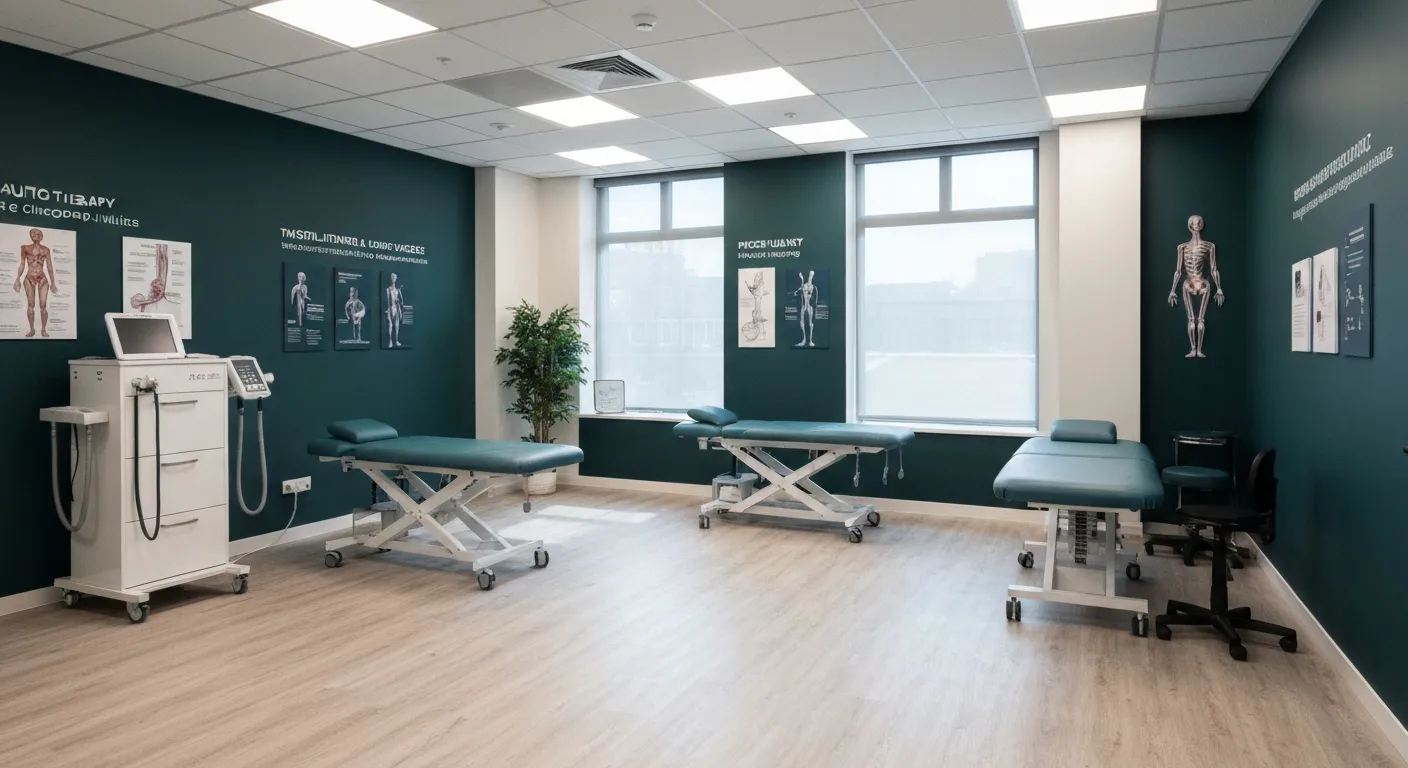The Key Advantages of Chiropractic Care for Back Pain Sufferers
October 27, 2025
8 min

Understanding Chiropractic Care for Back Pain
Back pain is a widespread condition affecting millions globally, leading many to seek effective treatment options. Chiropractic care has emerged as a popular, non-invasive approach to managing back pain, focusing on spinal health and improving overall function. This article explores the key advantages of chiropractic care for individuals suffering from back pain, emphasizing its benefits, safety, and holistic approach to healing.
What is Chiropractic Care and How Does It Address Back Pain?

What is chiropractic care and how does it work for back pain?
Chiropractic care is a drug-free and non-invasive treatment focused on diagnosing and treating disorders of the musculoskeletal and nervous systems, especially those affecting the spine. It aims to alleviate pain, improve mobility, and enhance overall body function. Learn more about chiropractic care for back pain and its benefits.
Primary techniques used, including spinal manipulation
A key technique in chiropractic care is spinal manipulation or chiropractic adjustment. Trained chiropractors use their hands or specialized instruments to apply controlled, quick force to spinal joints. This process realigns the spine, improves joint mobility, and can produce a characteristic popping sound caused by joint gas release. Sometimes, chiropractors also incorporate other manual therapies, such as massage and trigger point therapy, alongside rehabilitative exercises. For detailed explanations, see spinal manipulation benefits and therapeutic techniques.
How chiropractic care targets musculoskeletal and nervous system disorders
By correcting misalignments and improving joint function, chiropractic care reduces muscle tightness and nerve irritation. This helps alleviate symptoms like pain, numbness, tingling, and weakness. The treatment supports the nervous system’s health, promoting the body's natural healing processes without drugs or surgery. More about chiropractic care for musculoskeletal disorders and nervous system treatments can be found here.
Common conditions treated such as low back pain, neck pain, and disc problems
Chiropractors commonly treat acute and chronic low back pain, neck pain, disc herniations, muscle spasms, sciatica, and headaches related to spinal issues. It’s often recommended as a first-line, conservative approach before considering injections or surgery. More information is available on low back pain treatment with chiropractic care and conditions treated by chiropractors.
The role of spinal manipulation in pain relief and function improvement
Research indicates that spinal manipulation can effectively relieve pain and improve functional ability, particularly in acute low back pain cases. It helps restore proper spinal alignment, reduce inflammation, and improve flexibility and strength, contributing to enhanced quality of life and reduced reliance on medications. Evidence on the clinical effectiveness of chiropractic spinal manipulation and benefits of chiropractic care supports these findings.
Clinical Effectiveness: Evidence Supporting Chiropractic Treatments for Back Pain

How effective is chiropractic care for back pain according to research?
Numerous studies demonstrate that chiropractic spinal manipulation provides moderate improvements in pain relief and enhances function for individuals with acute, subacute, and chronic low back pain. Clinical guidelines often position chiropractic care as a first-line, conservative treatment before considering injections or surgeries.
Comparative research finds that chiropractic interventions yield outcomes similar to those achieved through physical therapy and medication, with benefits including reduced pain intensity, increased mobility, and improved daily functioning. For example, randomized controlled trials reveal significant decreases in disability scores and pain levels with chiropractic treatment.
Safety profile and frequency of adverse effects
chiropractic care is generally safe when delivered by licensed practitioners, with serious complications being very rare. Most adverse effects are mild and temporary, such as muscle soreness or fatigue lasting less than 24 hours. Studies consistently report a low incidence of minor side effects, reinforcing the favorable safety profile of spinal manipulation.
Clinical guidelines recommending chiropractic care
Professional guidelines, including those from the American College of Physicians and national bodies in the UK and US, endorse spinal manipulation as part of a multimodal approach for back pain management. These recommendations emphasize chiropractic care as an effective, non-invasive option, especially for non-specific low back pain and neck pain.
Outcomes across different patient populations
Research spans varied populations, from active-duty military personnel to chronic pain sufferers. Studies highlight that chiropractic treatments improve pain, physical function, and patient satisfaction across these groups. Benefits extend to reducing reliance on pain medications and enhancing quality of life, supporting wider adoption of chiropractic care in both acute and chronic cases.
The Multifaceted Benefits of Chiropractic Care Beyond Pain Relief
What additional benefits does chiropractic care provide besides pain relief?
Chiropractic care offers advantages well beyond just pain alleviation. One significant benefit is the improvement in posture, balance, and overall wellness. By realigning the spine, chiropractic treatments reduce nerve interference and muscle strain, which helps restore natural body balance and posture.
Increased range of motion and mobility is another important benefit. Adjustments help relax tight muscles and improve joint flexibility, making daily movements easier and reducing stiffness.
Chiropractic adjustments are also effective for managing headaches and migraines that stem from spine-related issues by relieving tension and improving spinal alignment.
Patients often report stress reduction and improved sleep quality after chiropractic care. These effects are linked to enhanced nervous system function and muscle relaxation.
Moreover, chiropractic care supports immune system function and mood. Proper nervous system performance facilitated by spinal alignment helps the body manage stress better, promotes overall health, and boosts emotional well-being.
Together, these holistic benefits make chiropractic care a valuable approach not only for back pain but for improving overall health and quality of life.
Safety and Patient Experience in Chiropractic Treatment

Is chiropractic care safe and what side effects might patients expect?
Chiropractic care is generally considered safe, especially when performed by licensed and trained professionals. Most patients tolerate spinal adjustments well, experiencing only minor side effects such as mild muscle soreness, fatigue, or occasional headaches. These symptoms typically resolve within 24 hours after treatment. For more information about safety and side effects of chiropractic adjustments, see reliable clinical resources.
What are the risks associated with neck manipulations and how are they mitigated?
Serious complications from chiropractic care are extremely rare but can include herniated discs, nerve pinching, or, very rarely, stroke following neck manipulations. These potential risks are mostly associated with improper technique or untrained practitioners. Licensed chiropractors conduct thorough patient assessments, including medical history reviews and physical examinations, to identify contraindications and tailor treatment accordingly, thus minimizing risk. For details on risks of spinal manipulation and safety protocols, refer to evidence-based guidelines.
How do patients perceive chiropractic care?
Patient satisfaction with chiropractic services is high, with many noting improvements in pain management and function. Chiropractic clinics often ensure good communication, timely appointments, and patient education, contributing to positive experiences and better access to care. For insights into patient satisfaction with chiropractic treatment and chiropractic care for back pain patient stories, see patient-centered research and success stories.
What are typical treatment plans and frequency of visits?
Initial chiropractic treatment usually involves 1-2 visits per week, focusing on spinal adjustments and supportive therapies. Visit frequency often decreases as patients experience improvement, with maintenance or follow-up visits scheduled as needed for chronic conditions. Treatment plans are personalized, aiming to restore function and reduce pain safely and effectively. For more on the frequency of chiropractic visits and typical procedures, consult trusted chiropractic resources.
Personalized and Holistic Approach to Managing Back Pain
How does chiropractic care for back pain personalize treatment for back pain sufferers?
chiropractic care for back pain creates individualized treatment plans based on comprehensive assessments. At the initial chiropractic consultation process, practitioners gather detailed medical history, conduct physical and orthopedic examinations, and review imaging if needed to pinpoint the specific causes of back pain.
Treatment usually involves spinal manipulation combined with complementary therapies such as massage and stretching for back pain and rehabilitative exercises for back pain. Chiropractors also counsel patients on lifestyle changes including ergonomics and back pain, flexibility exercises, strength-building for spine health, and activity modifications tailored to their daily routines.
Patient education plays a crucial role, empowering individuals to actively participate in their recovery and adopt habits that promote long-term spine health. This holistic chiropractic approach not only aims to relieve pain and improve function but also focuses on preventing future episodes through maintenance care and posture correction.
By blending hands-on therapy with personalized exercise and lifestyle advice, chiropractic care offers a natural, drug-free, and preventive pathway to managing back pain effectively.
Chiropractic Care as a Practical, Drug-Free Alternative for Back Pain Management
Why choose chiropractic care as an alternative for back pain management?
Chiropractic care for back pain offers a drug-free and non-invasive approach to managing back pain that can reduce reliance on pain medications, including opioids. By focusing on spinal manipulation techniques and lifestyle adjustments, chiropractic treatment often prevents or delays the need for more invasive procedures such as surgery or injections.
Reducing medication dependence and avoiding surgery
Patients receiving chiropractic care report less need for pain medications, fewer disabilities, and higher treatment satisfaction. This treatment modality’s gentle manual techniques improve spinal alignment and function, which can alleviate pain and help avoid surgery or injections often seen as last-resort interventions.
Cost-effectiveness and patient satisfaction
Chiropractic care is recognized as cost-effective compared to conventional treatments. Patients often experience notable improvements in pain and mobility with fewer sessions over time. High satisfaction rates stem from personalized treatment plans and a comprehensive focus on function, lifestyle, and prevention.
Benefits across diverse populations
Chiropractic therapy supports various groups, including seniors, athletes, and active adults. Seniors benefit from non-invasive pain relief and improved mobility, while athletes experience enhanced recovery and performance through better joint function and reduced muscle tension.
Early intervention to prevent chronic pain
Starting chiropractic care early in the pain cycle can prevent acute pain from developing into chronic conditions. Timely spinal manipulation and rehabilitative exercises promote quicker recovery, improved quality of life, and reduced long-term disability.
Chiropractic care stands out as a practical, holistic alternative for back pain management by providing natural pain relief, decreasing medication use, supporting diverse patient needs, and encouraging early treatment to avoid chronic disability.
Embracing Chiropractic Care for Lasting Back Pain Relief
Chiropractic care stands out as a safe, effective, and holistic treatment option for back pain sufferers. Supported by scientific research and clinical guidelines, it offers multifaceted benefits that go beyond pain relief to improve posture, mobility, and overall well-being. With personalized care plans and a strong safety profile, chiropractic care empowers patients to take an active role in their recovery while reducing reliance on medications and invasive procedures. Whether for acute flare-ups or chronic conditions, chiropractic care provides a promising approach to achieving lasting back health and an improved quality of life.
Recent articles

Long-Term Pain Relief Through Targeted Corrective Exercises

10 Benefits of Integrating Physiotherapy with Chiropractic Treatments

Corrective Exercises That Help Prevent Recurring Pain

8 Corrective Exercises Proven for Lasting Pain Relief

Lifestyle Habits for Maintaining a Healthy Spine

What You Will Experience at Your Initial Chiropractic Visit

What Happens at Your First Visit to a Chiropractor?

Focusing on Root Cause Analysis for Effective Pain Relief

Tips for Lifestyle Changes to Support Spinal Health

Holistic Treatment Plans: Alternatives to Surgery for Chronic Pain

Enhance Wellness Through Personalized Nutritional Counseling

Non-Invasive Pain Relief: Exploring Holistic Treatment Alternatives

Sciatica Relief Through Targeted Spinal Decompression

Integrating Physiotherapy with Chiropractic Treatments for Better Results

Testimonials That Demonstrate the Benefits of Chiropractic Care

The Power of Corrective Exercises in Pain Management

A Step-by-Step Guide to Your Initial Chiropractic Consultation

9 Nutritional Tips to Enhance Your Chiropractic Wellness Journey

Patient Experiences: How Chiropractic Care Changed Their Lives

Lifestyle Recommendations to Keep Your Spine in Top Shape

Effective Corrective Exercises for Long-Term Pain Relief

Back Pain Benefits: What Chiropractic Care Can Do for You

Spinal Decompression Techniques for Effective Sciatica Relief

Top Nutritional Counseling Tips for Enhanced Wellness

6 Lifestyle Habits That Boost Spine Health Daily

Discover Holistic and Non-Surgical Pain Relief Solutions

Exploring Holistic and Non-Surgical Treatment Options for Pain

The Role of Physiotherapy in Enhancing Chiropractic Care Outcomes

Complementing Chiropractic Care with Physiotherapy: What You Need to Know

What to Expect During Your First Chiropractic Visit

Simple Lifestyle Adjustments to Maintain a Healthy Spine

Personalized Nutritional Counseling for Improved Health Outcomes

Exploring Non-Surgical Treatments for Spine-Related Conditions

An Introduction to Spinal Decompression for Sciatica Patients

Transformative Success Stories: Patient Experiences with Chiropractic Treatments

Why Chiropractic Care Is Essential for Back Pain Relief

Addressing Underlying Causes Versus Symptom Management in Pain Care

The Role of Nutrition in Enhancing Chiropractic Treatment Effectiveness

Sciatica Treatment Options: Is Spinal Decompression Right for You?

Lifestyle Tips to Maintain a Healthy Spine and Prevent Back Issues

The Synergy Between Physiotherapy and Chiropractic Treatments

What Happens During Your Initial Chiropractic Consultation

Effective Corrective Exercises for Sustainable Pain Management

Taking a Root Cause Approach to Chronic Pain Management

Holistic Pain Management Techniques Without Surgery

How Patient Success Stories Validate Chiropractic Care Benefits

Spinal Decompression: Innovative Treatment for Sciatic Nerve Pain

Spinal Decompression Therapy: A Non-Invasive Approach to Sciatica Relief

Exploring Holistic Approaches Beyond Surgery for Pain Relief

Practical Lifestyle Advice to Support a Healthy Spine Every Day

Corrective Exercise Routines Designed for Long-Term Pain Prevention

Real Patient Stories: Overcoming Chronic Pain with Chiropractic Care

Lifestyle Changes That Promote a Healthy Spine and Prevent Injury

How Addressing the Root Cause of Pain Leads to Lasting Relief

Non-Surgical Holistic Therapies to Manage Chronic Pain Effectively

Nutritional Counseling's Impact on Physical Health and Healing

Benefits of Regular Chiropractic Care for a Stronger Back

Your First Chiropractic Visit: What to Expect and How to Prepare

Patient Experiences: How Chiropractic Care Transformed Their Lives

Exploring Holistic, Non-Surgical Options for Pain Management

Combining Physiotherapy with Chiropractic Treatments for Enhanced Recovery

Holistic Treatments That Offer Alternatives to Surgery for Pain Relief

Corrective Exercise Strategies for Long-Term Spine Health

How Physiotherapy Complements Chiropractic Adjustments for Better Outcomes

First-Time Chiropractic Visitors: What You Should Know

Understanding the Importance of Treating Pain at Its Source

Adopting Lifestyle Changes to Support Your Spine's Wellness

Utilizing Physiotherapy to Enhance Chiropractic Treatment Outcomes

The Key Advantages of Chiropractic Care for Back Pain Sufferers

Why Focusing on Root Causes Improves Pain Treatment Success

Corrective Exercises That Promote Lasting Pain Relief and Mobility

Sciatica Relief Through Targeted Spinal Decompression Techniques

Preparing for Your First Chiropractic Appointment with Confidence

Healthy Lifestyle Habits for Maintaining Spinal Alignment

Success Stories Highlighting Chiropractic's Role in Pain Recovery

Top Benefits of Chiropractic Care for Chronic Back Pain

Nutrition Tips to Boost Your Overall Wellness and Recovery

How Chiropractic Care Alleviates Back Pain Naturally

How Nutritional Counseling Supports Overall Wellness and Spine Health

Step-by-Step Guide to Your First Visit with a Chiropractor

Using Nutrition to Support Chiropractic and Overall Wellness

Integrating Physiotherapy in Your Chiropractic Healing Journey

How Physiotherapy Complements Chiropractic Adjustments for Faster Healing

Lifestyle Tips for Maintaining a Healthy Spine and Preventing Back Pain

Heartwarming Patient Testimonials Highlighting Chiropractic Success

How Proper Nutrition Supports Chiropractic and Physiotherapy Treatments

Combining Physiotherapy and Chiropractic Treatments for Optimal Recovery

Why Chiropractic Treatments Are Effective for Managing Back Pain

Choosing a Chiropractor: Tips for Finding a Trusted Provider

Integrating Physiotherapy and Chiropractic: Benefits and What to Expect

How Tailored Corrective Exercises Can Aid in Pain Management

Chiropractic Care: A Proven Solution for Alleviating Back Pain

What to Expect at Your First Chiropractic Visit: A Comprehensive Guide

The Importance of Root Cause Analysis in Effective Pain Management

The Role of Corrective Exercises in Sustaining Pain-Free Living

Combining Chiropractic and Physiotherapy for Comprehensive Pain Relief

How Addressing Underlying Causes Improves Pain Treatment Effectiveness

Maintaining Spinal Health Through Lifestyle Changes and Preventive Care

Understanding the Benefits of Chiropractic Adjustments for Back Pain Sufferers

